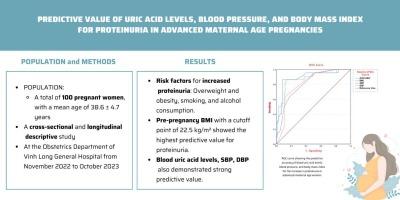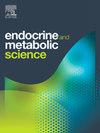Clinical significance of uric acid, blood pressure anticipating proteinuria worsening in pregnant women of advanced age
Q3 Medicine
引用次数: 0
Abstract
Background
Women of advanced maternal age are considered a high-risk obstetric population. Increases in serum uric acid levels, body mass index, and blood pressure have been associated with a higher likelihood of developing proteinuria. However, data on the predictive value of these factors for proteinuria progression specifically in this population remain limited.
Objectives
To determine the optimal cutoff values of serum uric acid, body mass index, systolic blood pressure, and diastolic blood pressure in predicting the progression of proteinuria in pregnant women of advanced maternal age.
Materials and methods
This was a cross-sectional descriptive study with longitudinal follow-up conducted among pregnant women who attended the Obstetrics Department of Vinh Long General Hospital from November 2022 to October 2023. Advanced maternal age was defined as maternal age of 35 years or older. Proteinuria was considered elevated when the 24-h urinary protein level reached ≥300 mg after the 20th week of gestation.
Results
A total of 100 pregnant women were enrolled, with a mean age of 38.6 ± 4.7 years. The proportions of active smoking and alcohol consumption were 18.0 % and 20.0 %, respectively. Overweight and obesity (OR = 6.06; 95 % CI: 1.97–18.59), smoking (OR = 3.89; 95 % CI: 1.30–11.59), and alcohol use (OR = 3.14; 95 % CI: 1.08–9.11) were significantly associated with the development of proteinuria. A pre-pregnancy body mass index (BMI) cut-off of 22.5 kg/m2 showed the highest predictive value for proteinuria progression, with an area under the ROC curve (AUC) of 0.89 (95 % CI: 0.81–0.98), sensitivity of 86.2 %, and specificity of 92.3 %. Serum uric acid (AUC = 0.88), systolic blood pressure (AUC = 0.81), and diastolic blood pressure (AUC = 0.80) also demonstrated strong predictive performance.
Conclusion
Overweight/obesity, smoking, and alcohol consumption were identified as risk factors for increased proteinuria. In addition, pre-pregnancy BMI, serum uric acid levels, systolic blood pressure, and diastolic blood pressure all demonstrated strong predictive value for proteinuria progression in pregnant women of advanced maternal age.

尿酸、血压预测高龄孕妇蛋白尿恶化的临床意义
高龄产妇被认为是高危产科人群。血清尿酸水平、体重指数和血压的升高与发生蛋白尿的可能性增高有关。然而,这些因素对蛋白尿进展的预测价值的数据仍然有限,特别是在这一人群中。目的确定血清尿酸、体重指数、收缩压和舒张压预测高龄孕妇蛋白尿进展的最佳临界值。材料和方法本研究是一项横断面描述性研究,对2022年11月至2023年10月在永隆总医院产科就诊的孕妇进行纵向随访。高龄产妇定义为35岁或以上的产妇。妊娠第20周后24小时尿蛋白≥300 mg为蛋白尿增高。结果共纳入100例孕妇,平均年龄38.6±4.7岁。吸烟和饮酒的比例分别为18.0%和20.0%。超重和肥胖(OR = 6.06; 95% CI: 1.97-18.59)、吸烟(OR = 3.89; 95% CI: 1.30-11.59)和饮酒(OR = 3.14; 95% CI: 1.08-9.11)与蛋白尿的发生显著相关。孕前体重指数(BMI)截止值为22.5 kg/m2,显示出蛋白尿进展的最高预测值,ROC曲线下面积(AUC)为0.89 (95% CI: 0.81-0.98),敏感性为86.2%,特异性为92.3%。血清尿酸(AUC = 0.88)、收缩压(AUC = 0.81)和舒张压(AUC = 0.80)也显示出很强的预测能力。结论超重/肥胖、吸烟和饮酒被确定为蛋白尿增加的危险因素。此外,孕前BMI、血清尿酸水平、收缩压和舒张压均显示出对高龄孕妇蛋白尿进展有很强的预测价值。
本文章由计算机程序翻译,如有差异,请以英文原文为准。
求助全文
约1分钟内获得全文
求助全文
来源期刊

Endocrine and Metabolic Science
Medicine-Endocrinology, Diabetes and Metabolism
CiteScore
2.80
自引率
0.00%
发文量
4
审稿时长
84 days
 求助内容:
求助内容: 应助结果提醒方式:
应助结果提醒方式:


